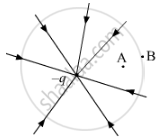Advertisements
Advertisements
प्रश्न
The field lines of a negative point charge are as shown in the figure. Does the kinetic energy of a small negative charge increase or decrease in going from B to A?

उत्तर
From the given field lines, we can say that the electric field present due to the given point charge will be directed towards the centre. Since we know that a negative charge always experiences a force in the direction opposite to that of the external electric field present, the negative charge will experience the force away from the centre. This will cause its motion to retard while moving from B to A. Hence, its kinetic energy will decrease in going from B to A.
APPEARS IN
संबंधित प्रश्न
What is the amount of work done in moving a point charge Q around a circular arc of radius ‘r’ at the centre of which another point charge ‘q’ is located?
The bob of a simple pendulum has a mass of 40 g and a positive charge of 4.0 × 10−6 C. It makes 20 oscillations in 45 s. A vertical electric field pointing upward and of magnitude 2.5 × 104 NC−1 is switched on. How much time will it now take to complete 20 oscillations?
A solid sphere of radius R has a charge Q distributed in its volume with a charge density ρ = kra, where k and a are constants and r is the distance from its centre. If the electric field at r = `"R"/2` is `1/8` times that at r = R, the value of a is ______.
An electron falls from rest through a vertical distance h in a uniform and vertically upward directed electric field E. The direction of electric field is now reversed, keeping its magnitude the same. A proton is allowed to fall from rest in it through the same vertical distance h. The time of fall of the electron, in comparison to the time of fall of the proton is ______.
A particle of charge q and mass m moves rectilinearly under the action of electric field E = A – Bx, where A and B are positive constants and x is distance from the point where particle was initially at rest then the distance traveled by the particle before coming to rest and acceleration of particle at that moment are respectively.
A charge Q is placed at the centre of the line joining two point charges +q and +q as shown in the figure. The ratio of charges Q and q is ______.

A charge of 4 × 10- 9c is distributed uniformly over the circumference of a conducting ring of radius 0.3 m. Calculate the field intensity at a point on the axis of the ring at 0.4 m from its center and also at the center?
Two equal point charges of the same sign are fixed on the y-axis, on either side of the origin equidistant from it, with the distance between them d. A third charge moves along the x-axis. The distance of the third charge from either of the two fixed charges when force on the third charge is maximum will be ______ cm.
[d = 10 cm]
